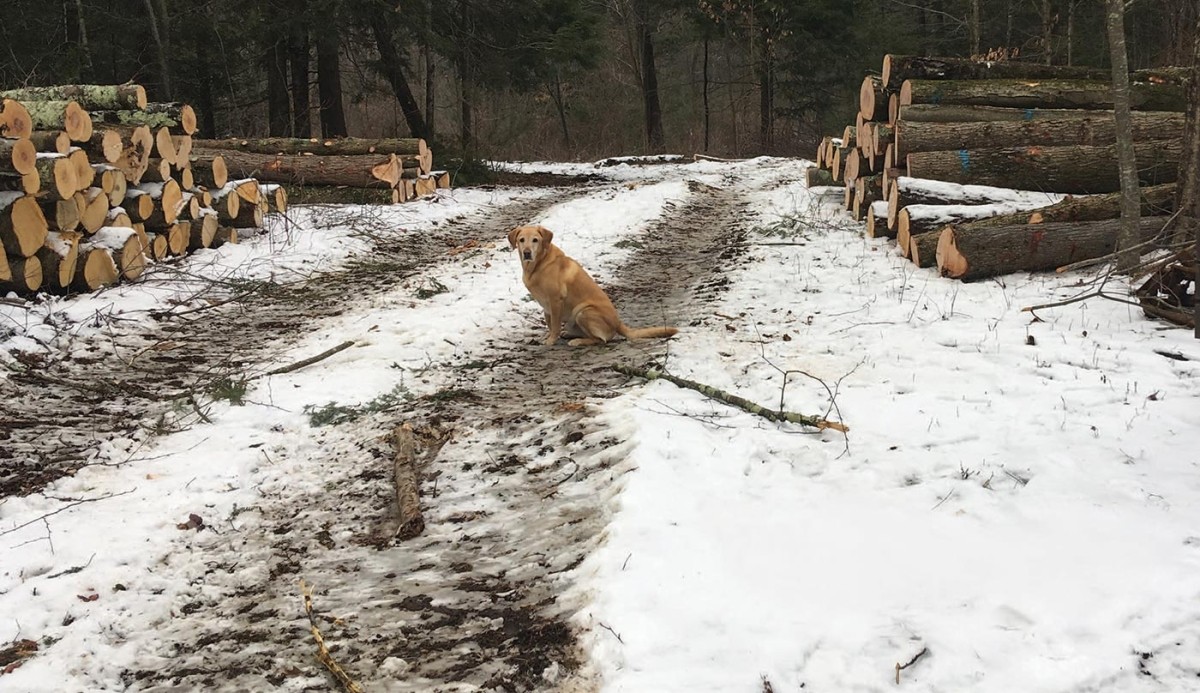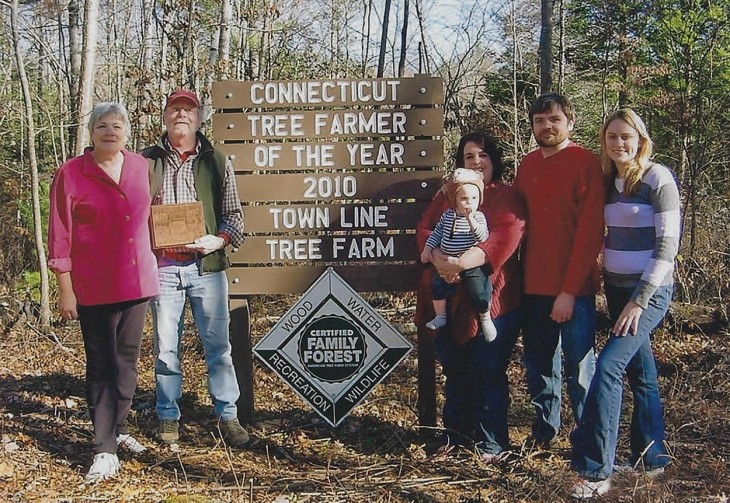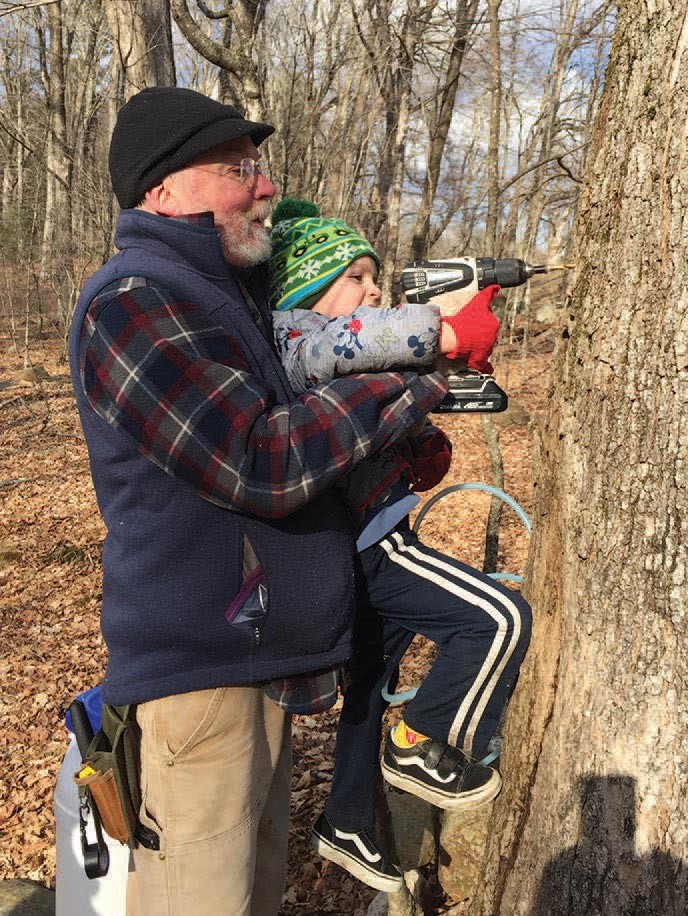
Tucked into the northeast corner of Connecticut, Steve and Karen Broderick’s 42-acre Town Line Tree Farm straddles the towns of Eastford and Woodstock. The Brodericks purchased this land in 1991, built a house here three years later, and have tended to the forest for more than three decades.
Steve worked as the extension forestry specialist for the University of Connecticut for 30 years, then as the half-time director of a small conservation education center in Goodwin State Forest. He’s also a founding member of the Eastern Connecticut Forest Landowners Association (ECFLA), where he sat on the board for some 40 years. All that is to say he has a pretty good understanding of the region’s forests – and how to manage his family’s 42 acres.
The property contains a carefully managed 4-acre sugarbush, about 8 acres of wetlands, an acre behind the house planted in Christmas trees, and roughly 7 acres of forest that exhibit old growth characteristics. The Brodericks have managed the property for maple production, timber harvests, firewood, and wildlife habitat.
“I think it’s important to note that you can manage a stand or a property for harvestable products – timber and fuelwood – and at the same time, you can enhance that property for wildlife habitat,” Steve said. “The two are not opposed – they’re compatible in many situations. We’ve tried to do that here.”
He has managed Town Line Tree Farm using the same tactics and philosophy he preached to landowners during his years as an extension forester. One of those is to consider not only his own property when making management decisions, but the surrounding landscape as well.
“I spent 30 years teaching landowners, ‘Don’t just stand on your boundaries and look in, stand at your boundaries and look out and think about what kind of habitats are abundant around you and what types are in short supply. Think about what niche you can fill that needs filling as a forest owner and manager,’” Steve said. “A 42-acre piece is relatively small, and yet we are adjacent to some 600 contiguous acres here, pretty much all forested, that are permanently protected through conservation easements.”
That includes two other parcels that were, along with the Brodericks’ land, originally part of a 180-acre farm. Each parcel is protected by a conservation restriction that prohibits development beyond a single-family dwelling. Just to the south sits another 15,000 acres of state forest land, while directly north lie close to 20,000 acres owned by Yale University, Nipmuck State Forest, a Boy Scout camp, and Paul Newman’s Hole in the Wall Gang Camp. It’s all part of the Last Green Valley Natural Heritage Corridor, which stretches from northeastern Connecticut into south-central Massachusetts.
“You can argue that this little area is disproportionally important from a landscape perspective, because we bridge those two large landscapes,” Steve said. “Connectivity on the land is very important from a wildlife perspective and other purposes. We’re all acutely aware of that, and we all maintain contiguous forest canopy on our properties to encourage that connectivity.”
The location is also at an intersection of forests types – between the northern hardwood region of northern New England and the upland central hardwood region farther south in the Appalachians. Oaks and hickories are dominant here, along with white pine, red maple, and birch. There’s also a good amount of northern red oak and sugar maple. The latter is especially prevalent in the sugarbush Steve has managed for three decades.
There’s a 16-by-24-foot sugarhouse on the property, fired – of course – by wood. Steve and Karen tap about 300 trees, and in a good year produce between 60 and 70 gallons of syrup, which they sell, mainly to repeat customers, and share with their family.
“It falls somewhere between a hobby and a small business. We clear enough money in a good year to help pay for a vacation later in the summer,” said Steve. “I figure between my maple syrup income, the money I save heating my house with firewood as a byproduct of my other forestry work, and the annual value growth rate of my timber, my tree farm annually produces more than twice what my taxes are for the house, outbuildings, and land. I take some pride in the fact that good forest management can be sustainable, can be good for the environment, and can also pay for itself.”
The tree farm is currently in its third 10-year management plan, and Steve reports that “acceptable growing stock” on the property has improved through the years. That’s forester speak for “trees that have the potential to increase in value at an acceptable rate over the next decade,” he said. “In the 30 years that we’ve been here, the percentage of stems that were acceptable growing stock has gone from something like 30 percent to close to 80 percent,” he said. “And at the same time, we’ve harvested and sold timber several times and created an area that provides a lot of great habitat for a lot of species.”
Wildlife includes bobcat, coyote, porcupine, deer, turkey, bear, and many species of migratory songbirds. There is one area of the property, however, that the Brodericks have never harvested. In fact, as far as Steve can tell, this area – about 7 acres, in the spot farthest from the original farmhouse – hasn’t been touched for more than 200 years.
“It’s routine for me to drill a 22- to 24-inch oak there and count 220 rings,” he said. “I maintain a trail through that area, but I don’t do anything else there. When I lead tours on the property, I like to walk people through there and point out some of the characteristics of an older growth forest that are subtle to the untrained eye.”
As most any forest manager knows, invasive species are part of the process of stewarding land. For the Brodericks, that has mainly involved cutting back and spraying Japanese barberry encroaching on the sugarbush. For the past decade, it has also meant removing Japanese stiltgrass, which arrived on skidder tires during a timber harvest years ago. Steve has also, unsurprisingly, seen evidence of emerald ash borer on the property, along with other pests, from spongy moth to hemlock woolly adelgid. But he’s hopeful for the future of the forests.
“I think nature finds a way to adapt, and it’s very, very difficult to eradicate a species. Elm and chestnut are the only examples I can think of where a tree really was pretty much eliminated from the forest,” he said. “But I still have elms on my property that are 12 or 14 inches in diameter. And I’ve got chestnuts that are 3 to 5 inches in diameter before they die. I suspect we’ll always have some oak and some hemlock and some ash out there.”



